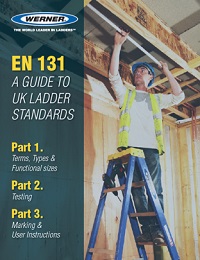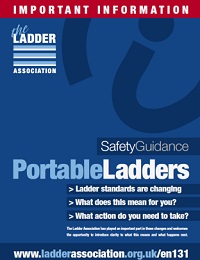EN131 Standards
Find out about the UK standards that cover different types of ladders here and about the latest changes to EN131 and the classifications for Professional and Non-Professional use.
Ladder standards have changed.
Ladder standards in the UK have changed to a single British and European standard covering all types of portable ladders. Our Werner ladders have changed to meet the latest EN131 standard, where applicable, with ladders having a load capacity of 150kg. There are one standard with two classifications: EN131 Professional and EN131 Non-Professional.
We've already taken steps.
See what Werner ladders go through before you even take a step on one.
EN131 at a glance | |
| There were 3 standards for ladders in the UK: | As of 1st January 2018 there is one standard with 2 classifications: |
EN131is for trade and light industrial use. | EN131 Professional |
BS2037 / BS1129 Class 1are for heavy duty and industrial use. | |
BS2037 / BS1129 Class 3are for domestic use. | EN131 Non-Professional |
What is EN131?
EN131 is a European committee for standardisation (CEN) harmonised standard for portable steps and ladders, manufactured from metal and certain other materials such as GRP. It covers minimum safety requirements.
There is one standard with two classifications: EN131 Professional and EN131 Non-Professional.
There are separate requirements for stepstools (EN14183), loft ladders (EN14975), telescopic ladders (EN131-6), mobile ladder with platform (EN131-7) and single or multiple joint ladders (EN131-4).
Why have ladder standards changed?
The European Commission was dissatisfied with elements of the previous standard and issued an EC Mandate for the standard to include additional requirements for stability, slip, durability and strength in position of use which will help in preventing the main causes of ladder related accidents.
How has EN131 changed?
A harmonised standard has been introduced in the UK which revokes any existing national versions.
The UK had differed from other European countries with a standard specific to ladders intended for domestic use (BS2037:1994 class 3) and with the introduction of the latest EN131 this domestic standard was withdrawn. BS2037/BS1129 Class 1 for heavy-duty and industrial use was also withdrawn.
There are two categories for ladders under EN131; one for Professional users and one for Non-Professional users reflecting that there are differences in the requirements for the performance of the ladder.
The EN131-6:2019 for telescopic ladders has also been introduced in early 2019 and the EN131-6:2015 was also withdrawn.
The EN131 part 4 (2007) for multi-purpose hinged ladders was also withdrawn, and the EN131-4 has also been introduced.
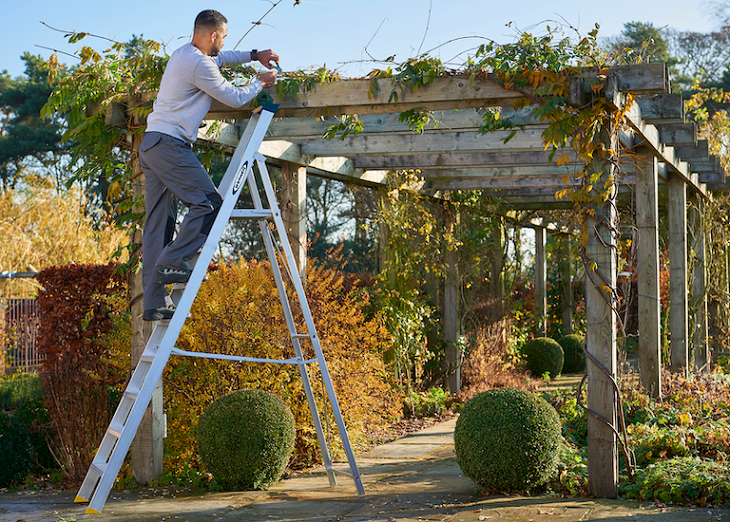
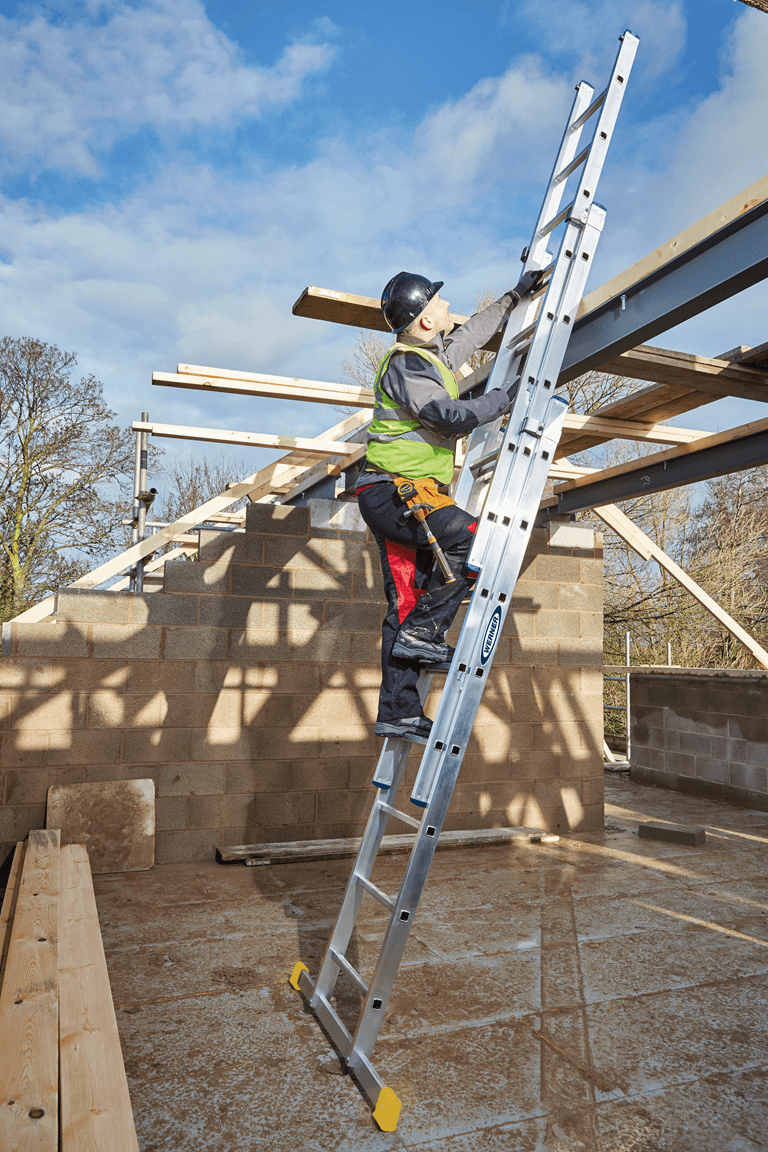
What are the main differences?
Many of the characteristics of the standards are similar but the latest EN131 has introduced stabilisers on ladders over 3m, slip tests, cycle durability tests, as well as tests for ladders in the position of use. Maximum load has been standardised at 150kg load rating.
Has the introduction of the latest harmonised EN131 affected the range and availability of products in the UK?
Yes, the domestic use (Class 3) range and products have been withdrawn and replaced by the latest EN131 Non-Professional rating and the industrial Use (Class 1) range and products have been withdrawn and replaced by the latest EN131 Professional rating.
Is compliance optional?
Ladder standards in the UK are optional but as the UK has participated fully in the standards development, Trading Standards and the HSE will expect new ladders to comply after a period of grace to January 2019.
When did the latest harmonised EN131 come into force in the UK?
There are three main parts to the latest standard: Part 1 - Terms, Types & Functional sizes, Part 2 - Testing and Part 3 - Marking & User Instructions. Parts 1 & 2 were introduced in January 2018 with a year for manufacturers to transition to the latest standard, before the January 2019 deadline. Part 3 was released in early 2018 again manufacturers should comply from January 2019.
How will I know if a product is compliant with EN131?
Products will need to be independently tested and certified for compliance and labelled with the latest EN131 standard stating if suitable for Professional or Non-Professional use as per the icon.
EN131 Professional

EN131 Non-Professional

What happens to products that do not comply with EN131?
There is no legal requirement to conform to standards in the UK but safety bodies such as Trading Standards and the HSE will expect manufacturers to comply. They will not expect users such as utility companies to stop using their current products but as they replace their ladders they should comply with the latest standard.
Suppliers and retailers have a period of grace to manufacture and sell through stocks of products compliant with prior standards – these products are safe to use, and there is no requirement to remove any product from sale for these reasons.
Overview of the Tests
The major changes to ladders following the introduction of the Part 1 EN131:2015 and Part 2 EN131:2017 Professional and Non-Professional standard includes adding stabilisers to extension ladders as well as the implementation of updated tests.
We take the quality and safety of our ladders very seriously and test in-house and with 3rd party certification bodies to ensure that our products are safe and durable. Take a look at how are Werner ladders tested to meet or exceed the requirements of the latest standard.
Leaning Ladder Tests
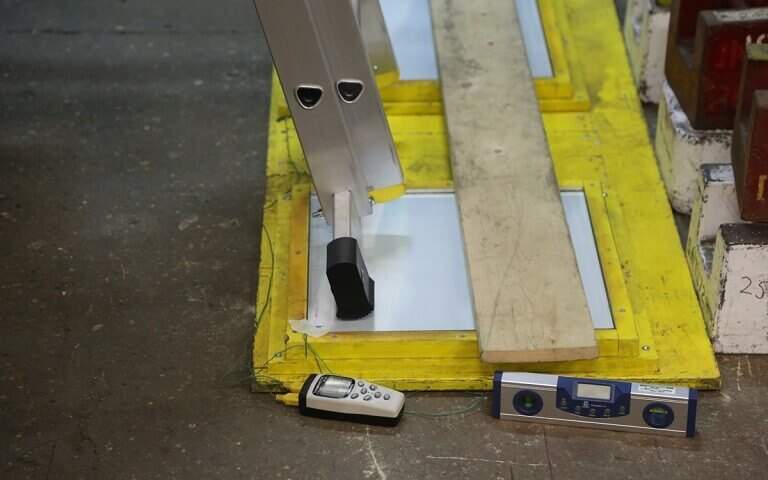
The Base Slip Test
What is tested?
Slip resistance of the feet whilst the ladder is in position of use.
How is it tested?
- The ladder is placed in position of use on a float glass surface.
- The ladder is tested with a static load of 150kg placed on the 4th rung down from the top of the leaning ladder.
- The load test is repeated 4 times.
The requirement
- The test requires the ladder to be no longer than 4m.
- In order to pass the test, the ladder feet must not move more than 40mm.
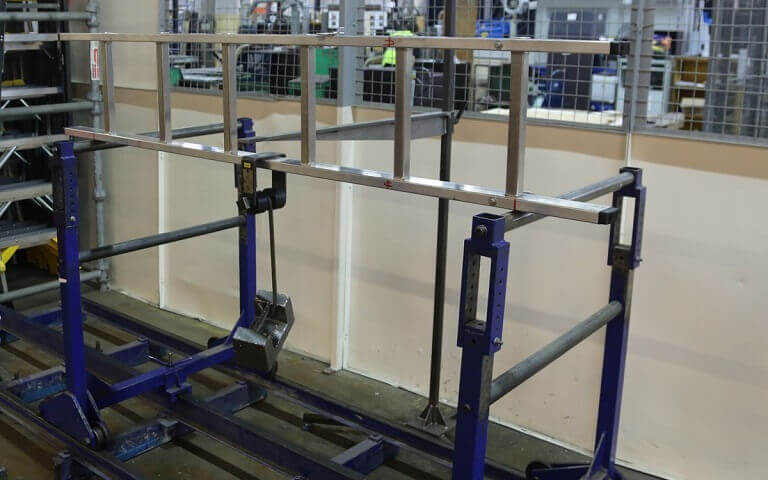
Lateral Deflection
What is tested?
The bend movement whilst the ladder is laid on its side.
How is it tested?
- Pre-conditioning and test loads are applied to the centre of the ladder section.
- Deflection measurments are taken both during the test and after the loads have been removed.
The requirement
- The maximum permissible deflection must not exceed a calculation based on the length of the ladder.
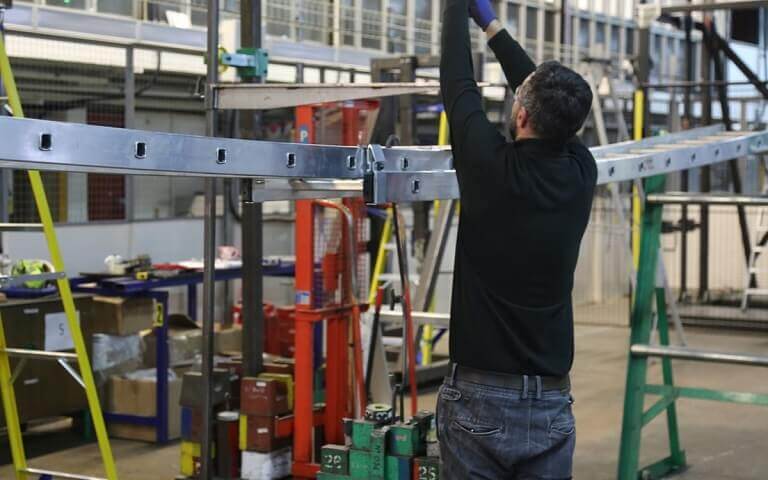
Bend Test
What is tested?
The bend that occurs whilst the ladder is laid on a test rig.
How is it tested?
- The ladder is laid flat in a fully opened position on a test rig with a vertical pre-load of 10kg applied to the centre of the ladder and centre between the stiles. After 60 seconds the load is removed and a measurement datum taken of the stiles.
- A test load of 76kg is applied to the centre of the stiles for a duration of at least 60 seconds.
The requirement
- The maximum permissible deflection must not exceed a calculation based on the span distance of the ladder.
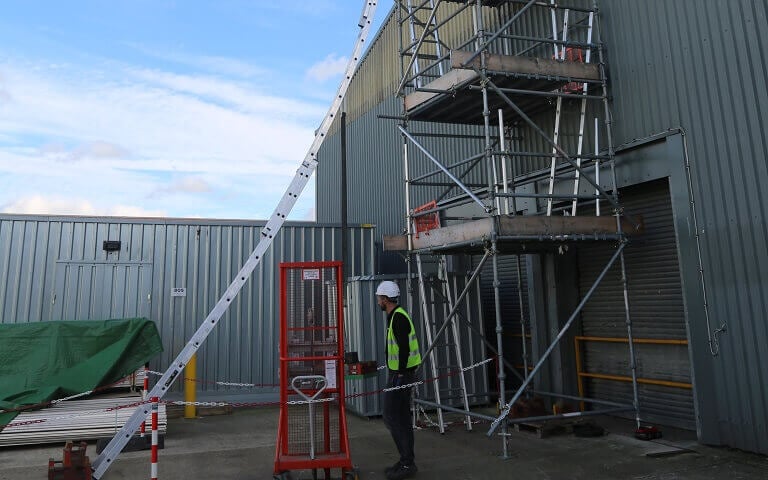
Strength Test
What is tested?
The strength of the ladder whilst the ladder is in the position of use.
How is it tested?
- A tread/rung of the ladder is tested with static loads of:
- Professional - 275kg
- Non-Professional - 229kg
The requirement
- After removal of the test load the ladder, stabilisers and their connections shall remain functional with no fracture or visible cracks.
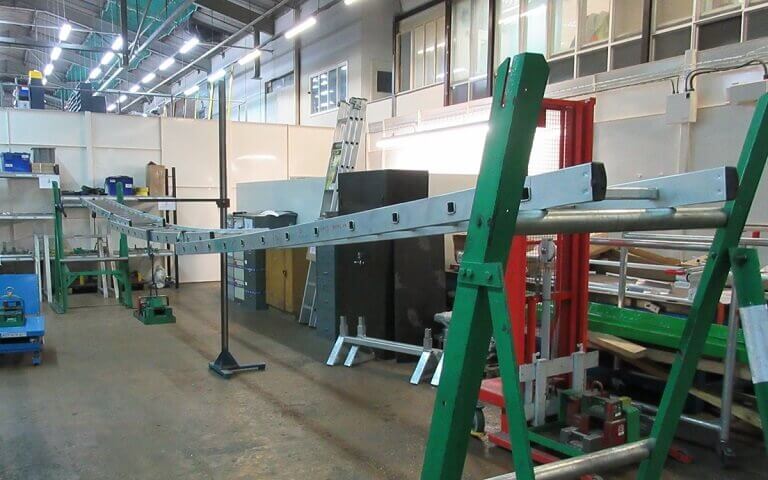
Torsion Test
What is tested?
The twist movement whilst the ladder is laid on a test rig.
How is it tested?
- The leaning ladder is laid flat on a test rig with a vertical load of 50kg applied to the centre of the ladder and centre between the stiles. After 30 seconds the load is removed and a measurement datum taken of the stiles.
- A vertical load of 65kg is applied to one stile for 30 seconds and then removed to take a further measurement.
The requirement
- The difference between the deformation of the two stiles should not exceed 0.07 times of the external width of the ladder section.
Standing Ladder Tests
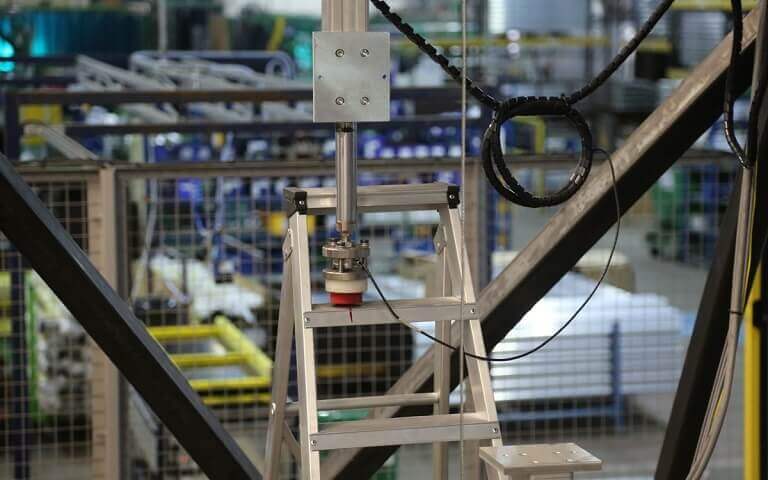
Durability Test
What is tested?
Durability of the ladder.
How is it tested?
- A load of 150kg is applied to the ladder alternating between the top tread/rung and the middle tread/ rung of the ladder.
- The test cycle is repeated:
- Non-Professional graded products: 10,000 cycles
- Professional graded products: 50,000 cycles
The requirement
- The ladder must be able to support the load without showing signs of rupture.
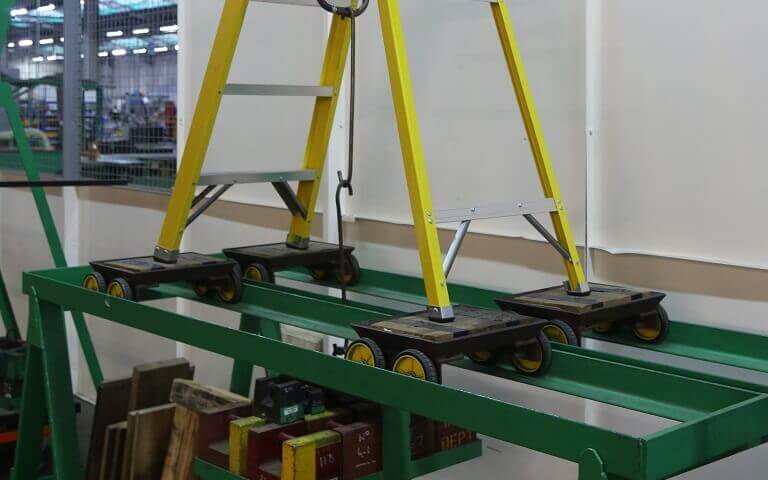
Opening Restraints and Hinge Test
What is tested?
The durability of the opening restraints and hinges of the standing ladder.
How is it tested?
- Each leg of the ladder is placed on a platform fitted with castors.
- A test load of 265kg is divided into 2 loads of 132.5kg each and distributed and applied to the top tread/ platform of the ladder, as close as possible to the ascending part of the ladder stiles. This test is conducted for a period of 60 seconds
The requirement
- The ladder must not show any deformation of the hinge joints or restraint devices. There must be no cracks, indentations or other visible damage and the ladder must remain in full working order.
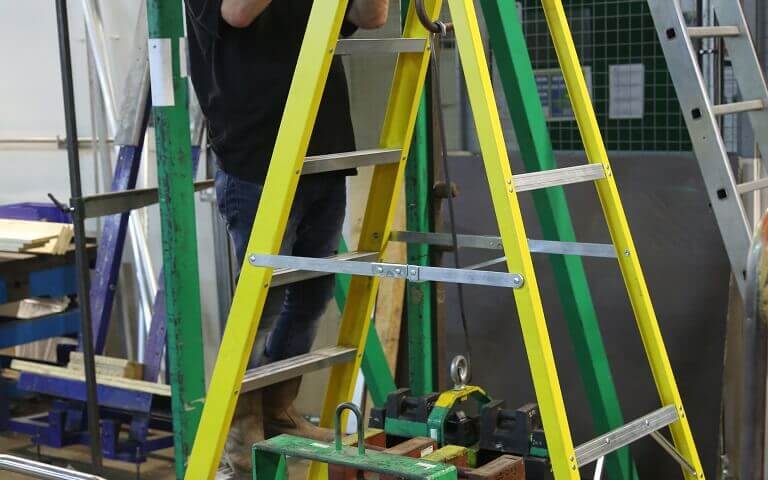
Torsion Test
What is tested?
The twist movement whilst the ladder is in the position of use.
How is it tested?
- One foot of the ascending side of a ladder is clamped to hold its position.
- A static vertical load of 75kg is attached to the top of the ladder.
- A horizontal test load of 14kg is applied to the top of the ladder to measure any movement to the ascending ladder foot that is not clamped.
The requirement
- The ladder must not move more than 25mm from its original position whilst the test load is applied.

